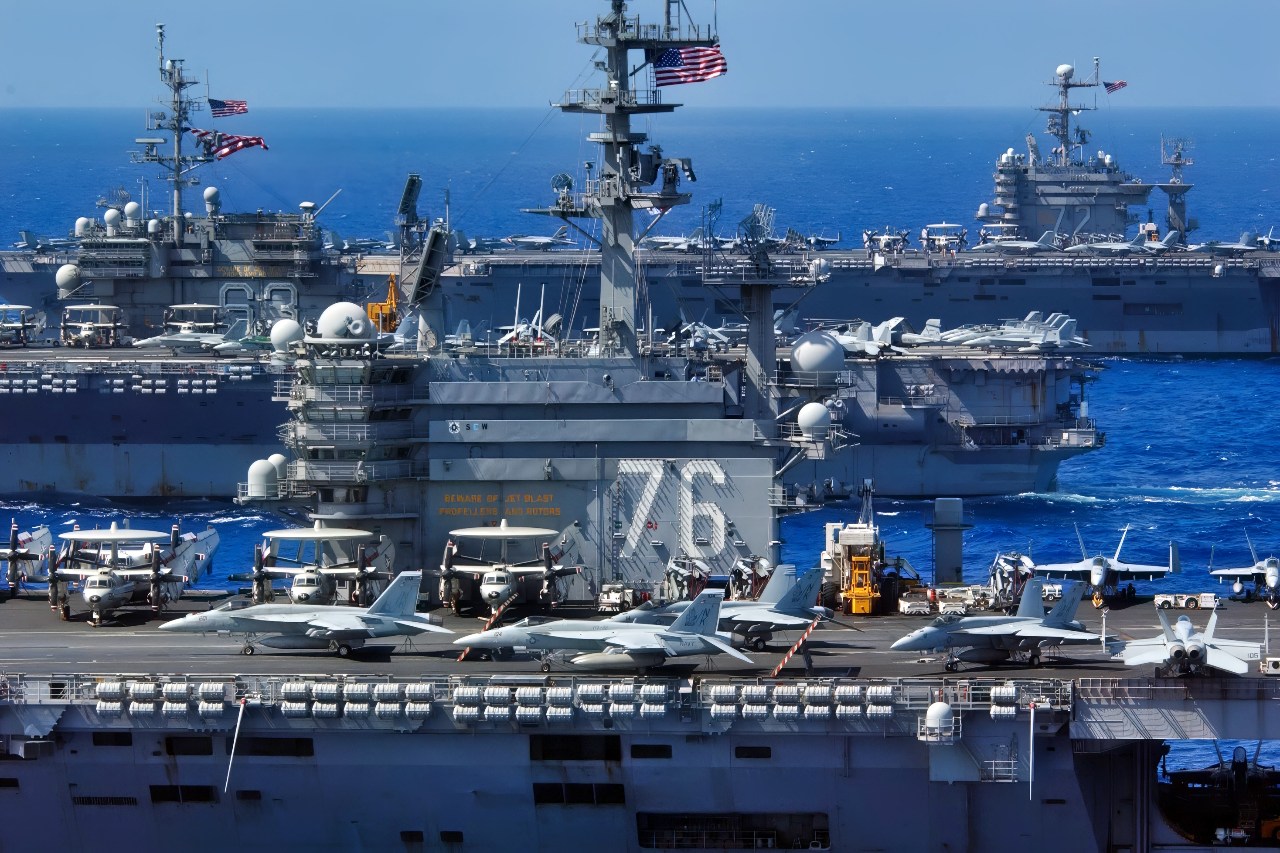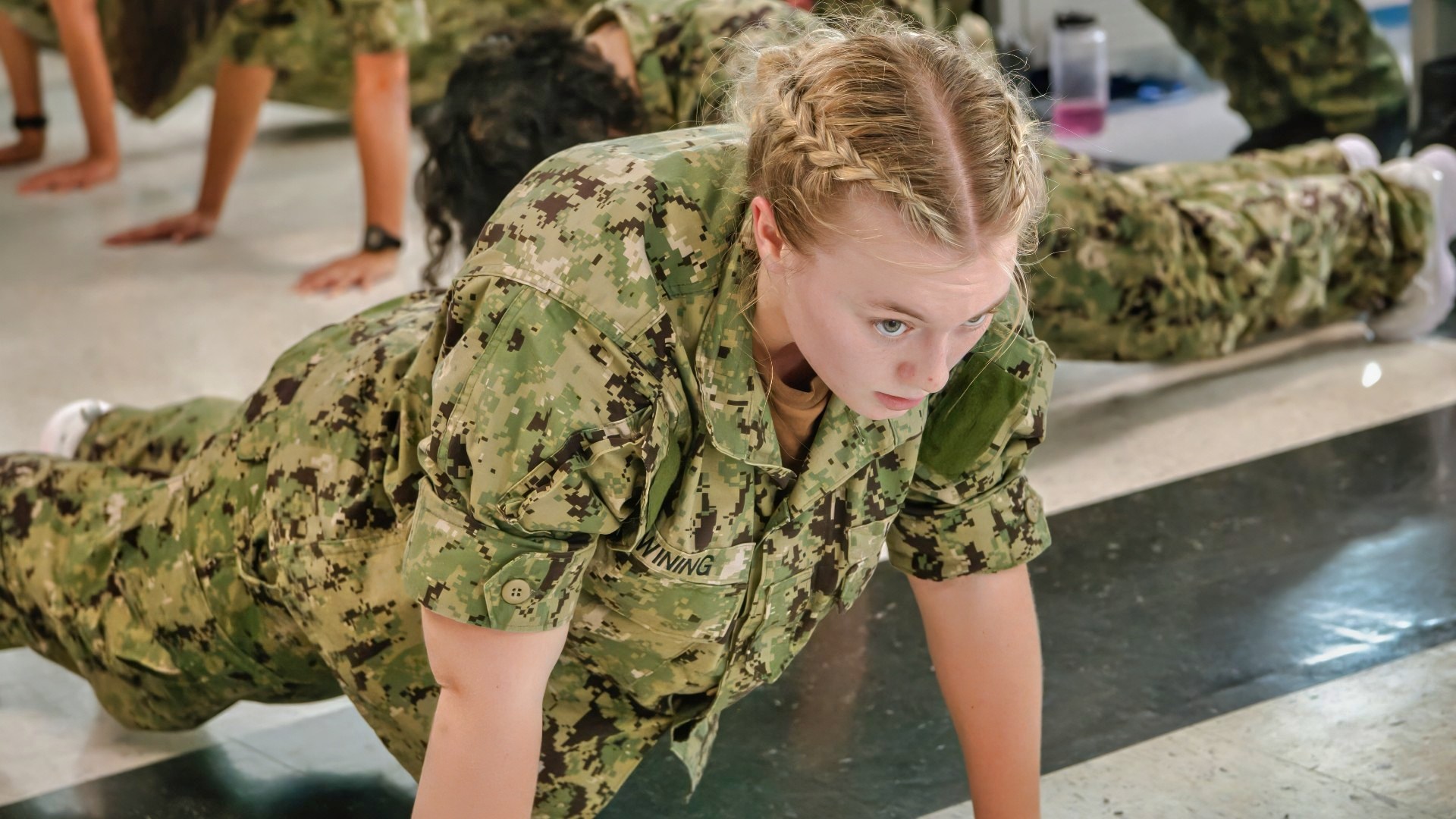Key Points and Summary – The U.S. Navy’s recruiting is surging, signing up over 44,000 sailors in FY2025—its best year in over two decades.
-While the Trump administration credits a “Trump bump” in patriotism and a return to a “warrior ethos,” Navy officials point to more concrete reforms.

Marine Cpl. Rodger Lagrange cleans the canopy of a Marine F/A-18A+ Hornet onboard the USS Harry S. Truman (CVN 75) while the aircraft carrier operates at sea on Feb. 14, 2005. The Truman Strike Group and Carrier Air Wing 3 are conducting close air support, intelligence, surveillance, and reconnaissance missions over Iraq. Lagrange is attached to Marine Fighter Attack Squadron 115 deployed from Marine Corps Air Station Beaufort, S.C.
(DoD photo by Airman Philip V. Morrill, U.S. Navy. (Released))
-These include significant pay raises, streamlining the enlistment process (like cutting tattoo waiver times from 30 days to 3), and new “smart marketing” to Gen Z.
-A key innovation is the Future Sailor Preparatory Course, which helps otherwise motivated recruits meet the minimum academic and fitness standards, successfully widening the recruiting pool.
The Navy’s Recruiting Numbers Are The Highest In 20 Years
After years of struggling to recruit, the military has seen a surge in the number of young men and women entering the ranks.
Experts differ on the reasons, but there is no mistaking that the military is once again not just reaching its goals but exceeding them.
President Donald Trump attributes the turnaround to a surge in patriotism inspired by his election and to new defense leaders who are rooting out what they decry as “wokeness” in the ranks and returning to their warfighting ethos.
Secretary of War Pete Hegseth has credited President Trump’s election with what he and other administration officials have called the “Trump bump” for military recruitment.
“They see leadership … that says, ‘We want you to be warriors. We’re not doing this politically correct garbage anymore. We’re doing war fighting,” Secretary Hegseth said on a visit to Normandy, France, in June to honor the 81st anniversary of D-Day.
There is an element of truth in that statement, especially for those who choose Combat Arms as an MOS (Military Occupational Specialty).
The Pentagon, however, has stated that the recruiting numbers began increasing in 2024, before Trump was elected.

USS Ronald Reagan (CVN 76), USS Kitty Hawk (CV 63), and USS Abraham Lincoln (CVN 72) cruise side-by-side in the Philippine Sea June 18, 2006, during exercise Valiant Shield 2006. The joint exercise consists of 28 naval vessels, more than 300 aircraft, and approximately 20,000 service members from the Navy, Army, Air Force, Marine Corps and Coast Guard. (U.S. Navy photo by Chief Photographer’s Mate Spike Call) (Released)
The Navy’s recruiting in particular is surging due to a combination of factors, including a stronger economy, improved recruiting strategies, especially targeting Gen-Z recruits, and new programs to help recruits qualify.
The Navy signed up 44,096 sailors in fiscal year 2025, officials announced in late September, beating its goal by almost 9 percent. A year ago, facing the same goal, the service squeaked past its annual quota by less than 1 percent.
“We haven’t recruited this number since the early 2000s. That dramatic change is by recognizing and adapting to the environment that exists and using smart marketing and advertising, freeing recruiters just to have more time to be out to prospect, rather than having to process the ones that they’ve already brought in to join,” Rear Adm. James Waters, commander of Navy Recruiting Command, said earlier this fall.
The 2025 recruiting class was the service’s highest recruiting number in more than 20 years.
Key initiatives include significant pay increases, the Future Sailor Prep Course, which helps applicants meet fitness and test-score requirements, and streamlining the application process, particularly medical waivers. The service is also using modern digital marketing and increasing its presence at youth events to connect with Gen Z.
Some of the factors that have helped improve recruiting include:
Economic Factors
A slowing civilian job market and recession fears are making military service a more attractive alternative for some young people. Better pay helps make military service and recruiting an easier sell to younger Americans.
Beginning in 2023, Congress passed three straight basic pay raises for troops, amounting to between 4.5 percent and 5.2 percent annually. Another 10 percent pay increase for junior enlistees – those in the lowest service ranks – went into effect this April, adding $3,000 to $6,000 per year to the pockets of each of those new soldiers.
These hikes marked the most significant increases in troops’ basic pay in two decades. The annual base salaries for new troops have increased from about $22,000 in 2022 to nearly $28,000 in 2025.
The promise of stability, benefits, and educational opportunities is appealing to many young people, especially as the cost of higher education rises.
Recruiting and Program Changes
The Navy has streamlined its administrative processes, reducing the time it takes for new sailors to get through the Military Entrance Processing Station from more than 30 days to fewer than 3. Admiral Waters stated that younger Americans have many more tattoos than those in previous generations.
“Young people today are much more inked than they were even a few years ago,” he said.
And last year it took an average of 30 days to get approval for tattoos; today it takes 2.7, Waters said.
The Future Sailor Preparatory Course (FSPC) is a program for individuals who want to join the U.S. Navy but may not meet the initial entry standards for physical fitness or the Armed Services Vocational Aptitude Battery (ASVAB) test.
It offers both an Academic Track to improve ASVAB scores and a Fitness Track to help recruits meet physical fitness and body fat standards. The program provides a path to success by giving potential recruits the training and confidence to succeed in boot camp.
The Navy has relaxed some requirements, such as allowing people without high school degrees to apply if they meet testing requirements and increasing the maximum age for enlisted recruits to 41 for most jobs.
The recruiting force has grown in size and is more motivated after addressing their concerns and ideas, helping remove barriers and improve productivity.
Marketing and Outreach, Particularly To Gen-Z
The Navy is using more modern, digital advertising and virtual reality technology to reach a younger demographic.
They are increasing their presence at youth-oriented events, including sports and STEM competitions, as well as through partnerships with organizations such as the High School All-American Bowl and Sneaker Con.
Marketing efforts are also being used to highlight specific high-demand roles like those in Naval Special Operations, which have resonated with younger Americans, Admiral Waters said, which speaks to what Secretary Hegseth told about the “macho, warrior ethos military.
These ads for Naval Special Operations, including Navy SEALs, aviation rescue swimmers, explosive ordnance disposal technicians, and special warfare combat crewmen, highlighted the service’s departure from “dirt wars” and move towards maritime operations.
“Those ads really approach Gen Z in a way that is more relatable and have generated a lot of those leads,” Waters said.
The “Forged by the Sea” campaign, which highlights unexpected opportunities like flying jets or traveling, aims to reframe the Navy as a career path by addressing misconceptions on platforms popular with Gen Z.
Additionally, the Navy uses virtual reality simulators, offers prep courses for those who don’t immediately qualify, and has increased its maximum enlistment age to attract a broader pool of recruits.
About the Author: Steve Balestrieri
Steve Balestrieri is a National Security Columnist. He served as a US Army Special Forces NCO and Warrant Officer. In addition to writing on defense, he covers the NFL for PatsFans.com and is a member of the Pro Football Writers of America (PFWA). His work was regularly featured in many military publications.
More Military
China’s New J-35 Navy Stealth Fighter Summed Up in 2 Words
China’s ‘Mighty Dragon’ J-20 Air Force Stealth Fighter Summed Up in 2 Words
China Is Trying to Turn the Indo-Pacific Into a Giant U.S. Navy ‘No-Go Zone’
$13 Billion Mistake? USS Gerald R. Ford Is the Navy’s Aircraft Carrier Agony
China’s ‘Thousands of Missiles’ Have a Message for U.S. Navy Aircraft Carriers











Krystal cane
October 27, 2025 at 9:46 pm
They are not